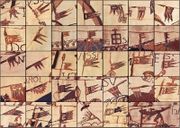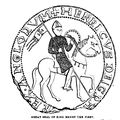Difference between revisions of "Banners"
(Created page with "{{Stars2|Category=Weapons}} Banners, standards, flags, gonfanon (guntfano) and pennons (pennants) were commonly adopted by the warriors of the 9th – 12th centuries. This ar...") |
m |
||
| Line 75: | Line 75: | ||
<br> | <br> | ||
{{Quote|50| | {{Quote|50| | ||
| − | " | + | "...that there might be a perpetual memorial of the royal character of this holy man [King Oswald], they hung up over the monument his banner of gold and purple." |
| | | | ||
Osthryth, queen of the Mercians [Project Gutenberg 2011] | Osthryth, queen of the Mercians [Project Gutenberg 2011] | ||
}}<br> | }}<br> | ||
| + | |||
| + | ==Late Roman Draco Standards== | ||
| + | |||
| + | {{evidence | ||
| + | |Art = | ||
| + | <gallery> | ||
| + | File:Banner St. Gallen Cod.22 140.jpg | c.883-900AD Carolingian <br> St. Gallen Cod.22 140 | ||
| + | File:Banner Bayeux Tapestry 71a.jpg | c.1076AD English <br> Bayeux Tapestry | ||
| + | </gallery> | ||
| + | |Literature = | ||
| + | {{Quote|50| | ||
| + | "Hic arripiens signum quod apud eo habebatur sacrum, leonis atque draconis desuper aquilae volantis insignitum effigie ..." | ||
| + | | | ||
| + | About Witikind, an adversary of Charlemagne. [Oakshott 1963:p178] | ||
| + | |Archaeology | ||
| + | }} | ||
| + | "... be the end would have been different. But Harold was struck, and cut down by a Norman sword when William's knights burst through the Huscarles to trample down the Dragon standard and Harold's banner of the Fighting Man." [Oakshott 1963:p.180] | ||
Revision as of 13:01, 31 January 2015
| Banners |
|---|
|
More Weapons pages
Banners, standards, flags, gonfanon (guntfano) and pennons (pennants) were commonly adopted by the warriors of the 9th – 12th centuries. This article attempts to briefly outline what the authors currently know about the subject.
The style of banner stays surprisingly consistent from the 9th to the 12th centuries and across Western Europe. For this reason we’ve decided to look at all the evidence together rather than, as we usually do, break the evidence into English, Carolingian, etc.
From Art
Pennons
These are triangular flags or streamers.
- Banner BL Cotton Caligula A XV f123r
c.1073AD English
BL Cotton Caligula A XV f123r
Banners
These are rectangular flags ending in ‘swallowtails’.
Before 1066AD
The Bayeux Tapestry
After 1066AD
From Literature
- Capitulary of Charles the Bald
|
“Let our envoys (missi nostril) see that the troops of every bishop, abbot, and abbess, march forth properly equipped, and with their Gonfalonier (cum Guntfannonario).” |
|
[Hewitt 1885: p.166] |
- Wace (Line 11,450)
|
“L’Apostoile. Un gonfanon li enveia.” |
|
[Hewitt 1885: p.166] |
- Beowulf
|
"High o'er his head they hoist the standard, |
|
[Fordham.edu] |
|
"To Beowulf gave the bairn of Healfdene |
|
[Fordham.edu] |
|
"His glance too fell on a gold-wove banner |
|
[Fordham.edu] |
- Bede – Ecclesiastical History of England
|
"His [King Edwin] dignity was so great throughout his dominions, that not only were his banners borne before him in battle, but even in time of peace,
when he rode about his cities, townships, or provinces, with his thegns, the standard-bearer was always wont to go before him. Also, when he walked anywhere along the streets, that sort of banner which the Romans call Tufa, and the English, Thuuf, was in like manner borne before him. |
|
[Project Gutenberg 2011] |
|
"...that there might be a perpetual memorial of the royal character of this holy man [King Oswald], they hung up over the monument his banner of gold and purple." |
|
Osthryth, queen of the Mercians [Project Gutenberg 2011] |
Late Roman Draco Standards
{{evidence |Art =
|Literature =
|
"Hic arripiens signum quod apud eo habebatur sacrum, leonis atque draconis desuper aquilae volantis insignitum effigie ..." |
|
About Witikind, an adversary of Charlemagne. [Oakshott 1963:p178] |
"... be the end would have been different. But Harold was struck, and cut down by a Norman sword when William's knights burst through the Huscarles to trample down the Dragon standard and Harold's banner of the Fighting Man." [Oakshott 1963:p.180]



